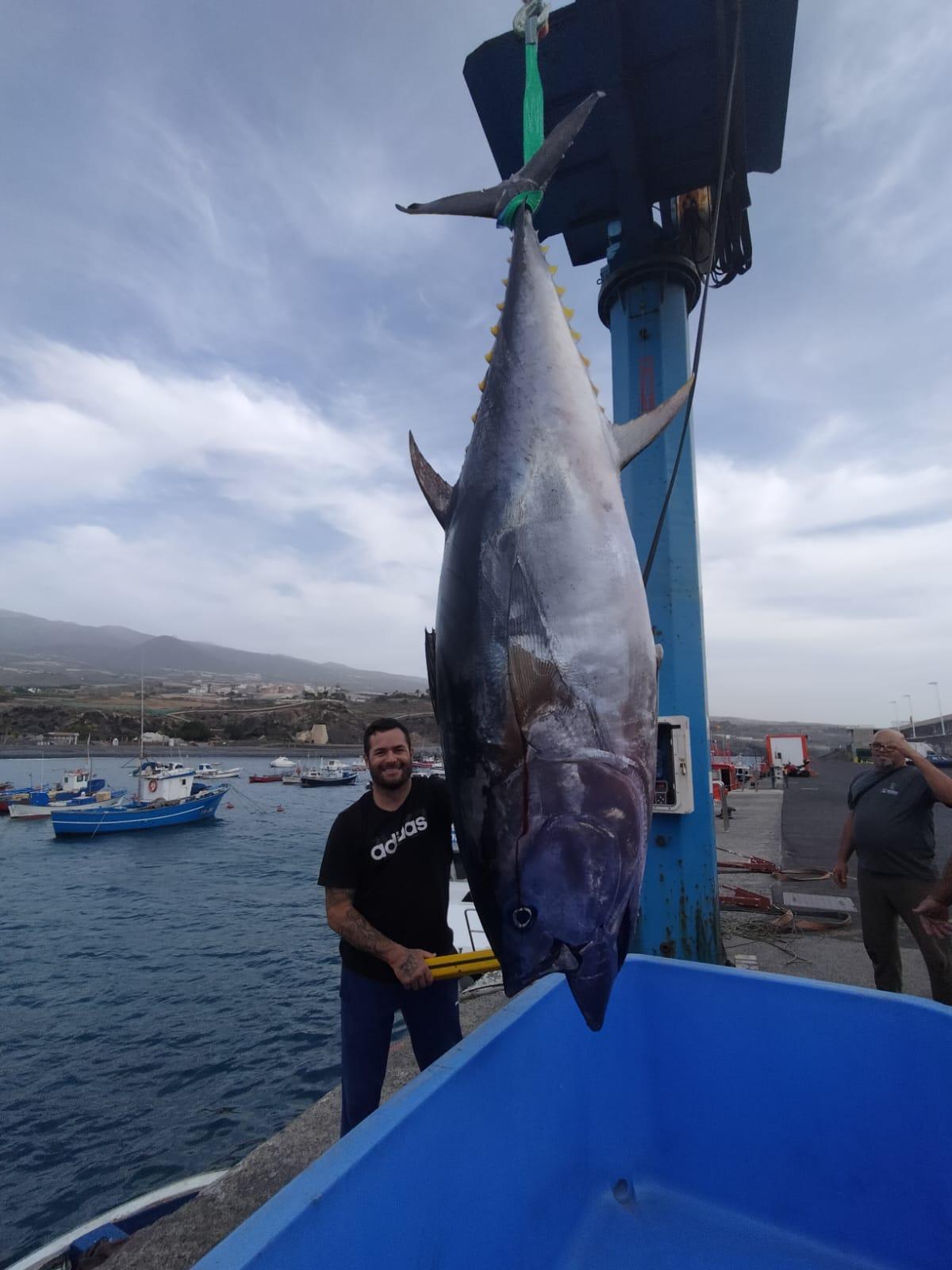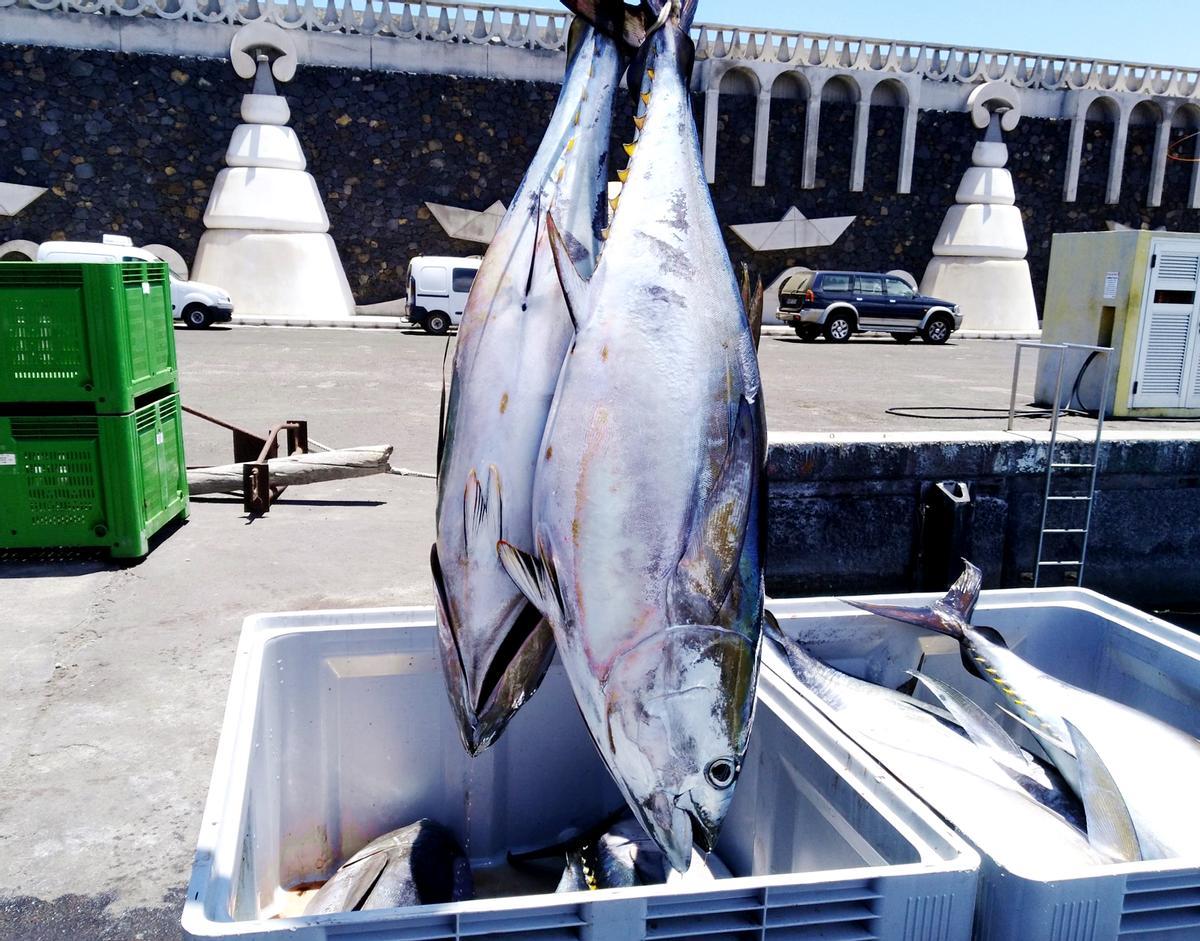Goyo Amaral and his son Yeray once again, like last year, are the fishermen who achievethe first catch of the bluefin tuna campaign in Tenerife, also known on the island as bigeye tuna. They achieved this on Monday morning about two miles off the coast of Los Gigantes, in the municipality of Santiago del Teide. This marks the capture of a specimen weighing 205 kilograms and measuring over two meters.
The first catch that kicks off this year’s campaign was long-awaited: it arrived eight days later than when the permit was issued, on January 29. The reason: strong gusts of wind that prevented the tuna fleet from going out to fish in the first days of the season.
In fact, the wind forced Goyo and Yeray Amaral to take their 9-meter long boat, the Luz Miguel, to the Port of Playa San Juan, in the municipality of Guía de Isora. There, they unloaded the tuna, whereas they usually do so at the Port of Los Cristianos (Arona).

On Monday, Yeray Amaral poses with the 205-kilogram bigeye tuna that inaugurates the fishing campaign for this delicacy in Tenerife. / Mercedes Méndez
And so begins a season that will last until the more than 250 artisanal fishing boats dedicated to bigeye tuna in the archipelago reach this year’s quota, set by the national government at 537.7 tons, slightly higher than in previous years. This quota is established to protect one of the most prestigious species in the top restaurants of the world, especially in Japan.
Goyo and Yeray Amaral will be able to fish around 3,000 kilograms during this year’s campaign, based on this quota. Like the rest of the thirty or so boats dedicated exclusively to tuna in Los Cristianos, they will have until next June to reach the maximum set by the Ministry of Agriculture, Livestock and Fisheries.
A season begins that will last until the more than 250 artisanal fishing boats dedicated to the bigeye tuna in the archipelago reach this year’s quota: 537.7 tons
This year is a “challenging” one, says Yeray Amaral. “If in previous years we sold a kilo for over 10 euros, this year the maximum price being asked is 7 euros, which significantly reduces profitability, considering how much effort it takes to catch a bigeye tuna,” explains the fisherman.
The specimen they caught this Monday, he and his father sold it to the association they are part of, Isla Tuna, which will likely market it in the Islands. “The international market is becoming increasingly complicated due to the boom in captive tuna production, especially in Spain,” says Yeray Amaral.
“The international market is becoming increasingly complicated due to the boom in captive tuna production”
This is despite the high price that a kilo of bluefin tuna fetches in the markets and the most exclusive restaurants, making this campaign the mainstay of the Tenerife fishing fleet and by far the most lucrative. Additionally, the bigeye tunas pass through the Canaries during their large migrations across the entire Atlantic, with optimal weight and maturation.
In Los Cristianos, there are home to or transit 30 of the Tenerife boats dedicated to tuna. They are not easy to locate and are fished artisanally: one by one and with a fishing rod, usually using mackerel as bait. One way to find them is to look for dolphins.

Specimens of bigeye fish caught in Canarian waters. / El Día
Apart from their gastronomic quality, specimens of the bluefin tuna –Thunnus thynnus– are part of a subspecies with incredible characteristics. They can reach lengths of up to 3.65 meters and weigh up to 900 kilograms, and can live up to 40 years. In addition, Atlantic bluefin tunas are among the fastest animals on the planet and also have the widest distribution.
This fish can reach speeds exceeding 75 kilometers per hour when chasing their prey or being pursued. Furthermore, they can dive to depths greater than 900 meters. These migratory animals can even cross the Atlantic Ocean, covering a distance of over 8,000 kilometers.















